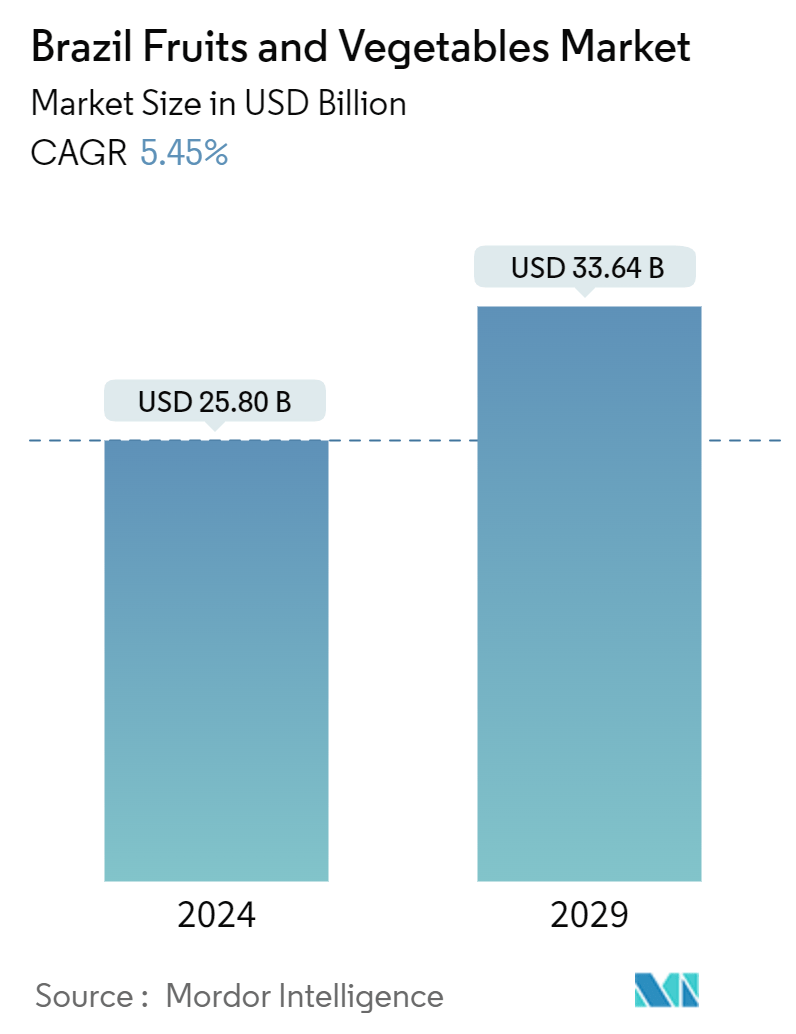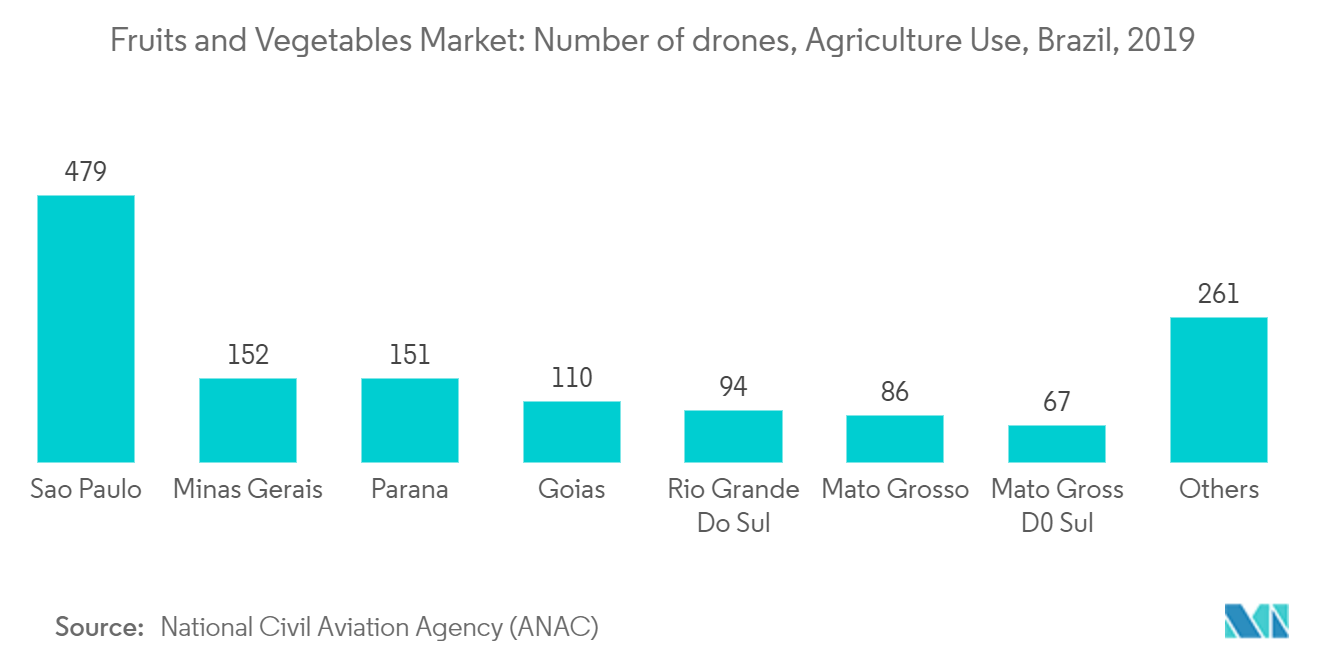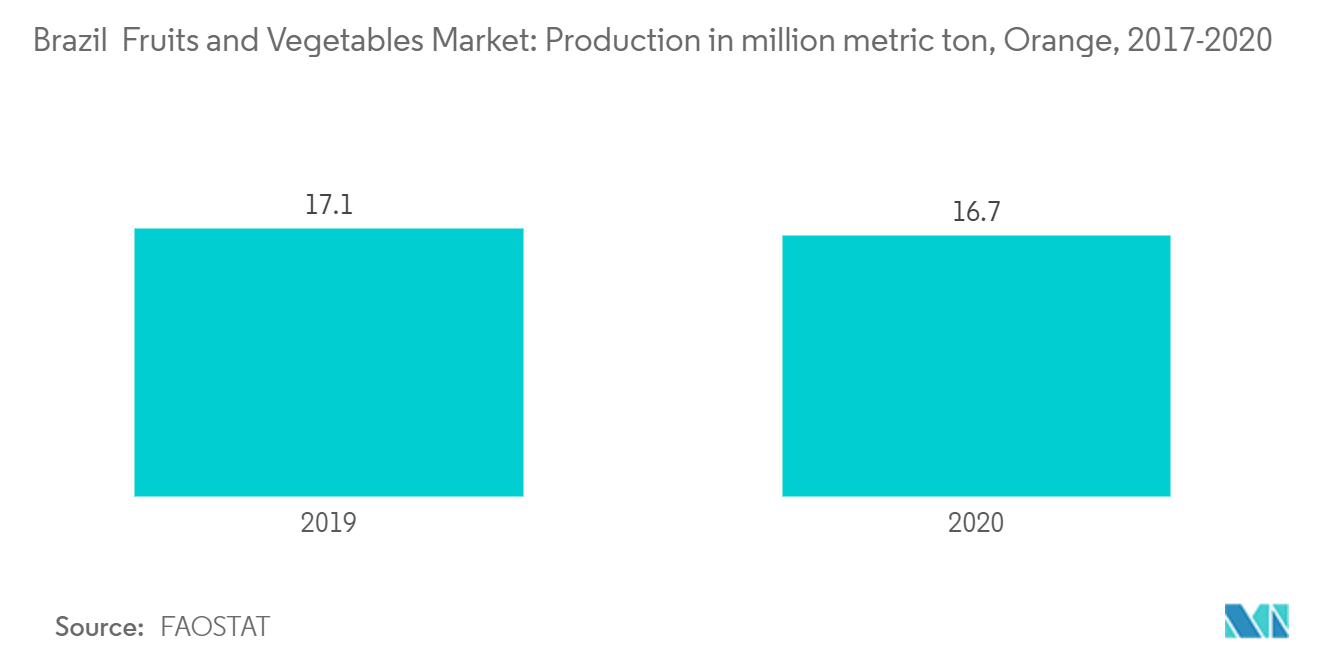Brazil Fruits and Vegetables Market Size

| Study Period | 2019 - 2029 |
| Base Year For Estimation | 2023 |
| Market Size (2024) | USD 25.80 Billion |
| Market Size (2029) | USD 33.64 Billion |
| CAGR (2024 - 2029) | 5.45 % |
| Market Concentration | Medium |
Major Players*Disclaimer: Major Players sorted in no particular order |
Brazil Fruits and Vegetables Market Analysis
The Brazil Fruits And Vegetables Market size is estimated at USD 25.80 billion in 2024, and is expected to reach USD 33.64 billion by 2029, growing at a CAGR of 5.45% during the forecast period (2024-2029).
The COVID-19 pandemic has had little effect on fruit and vegetable production throughout the country. Producers have taken a number of precautions and safety measures in the field and warehouses, such as distance restrictions between workers during harvesting and transportation.
Key factors in the growth of the fruits and vegetable market in Brazil are technological advancements, swelling population levels, strong economic growth, good availability of fruits and vegetable products, and expanding local production.
Some of the major fruits and vegetables produced are oranges, bananas, tomatoes, watermelons, and onions, among others. Bananas and oranges together make up around 49.3% of the gross fruits and vegetable production in Brazil, while tomatoes contribute to about 47% of the vegetables.
Moreover, to meet the export and consumer demand for fruits and vegetables, the government is planning to invest more in the agricultural sector by implementing emerging technologies.
Brazil Fruits and Vegetables Market Trends
Increased Adoption of Advanced Technologies in Fruit and Vegetable Cultivation
Brazilian farmers are increasingly adopting smart-farming technology in agriculture, including farm-management software, IoT, and smartphone. It is pertinent to note that precision agriculture has been the driver behind the increased adoption of such technologies. The percentage of farmers who have access to computers for farm management, laptops, internet access, and smartphones is significantly higher when the farmers adopt precision farming as against conventional farming. The adoption of precision farming has been more prevalent in horticultural crops, such as fruits, than the adoption in field crops.
Further, drones can be unmanned aerial vehicles ("UAVs") are one of the technological tools applied in smart farming. As of August 2019, there were almost 1,400 drones legally registered in Brazil for agricultural use. More than one-third of drones were registered in the state of São Paulo, according to National Civil Aviation Agency (ANAC). Brazil is one of the major users of drones in farming and is an established developer of unmanned aerial vehicles (UAVs) used in agriculture, forest, and other industry.
Further, the growing interest in greenhouse vegetable production is associated with the increase in consumer income, the urbanization of the Brazilian population, the increasing concern about food safety, the use of chemical pesticides, and the possibility of increasing water and fertilizer use efficiency.

Orange to Dominate the Fresh Produce Sector
Brazil has over 300 native fruits and nearly 40% of the world's total orange production with 16,524 thousand metric ton in 2021, and half of the orange juice production, with 1,123 thousand metric ton at 65 Degrees Brix in 2021, is concentrated in Brazil, which made Brazil the world leader in the production of oranges. The most common importing countries from Brazil are the United Kingdom, the United States, Germany, Argentina, Uruguay, Belgium, Canada, France, Italy, Portugal, and Spain. Brazil shares 13% in imports of oranges globally, with USD 302,128 thousand in 2021. The state of São Paulo is the largest producer in Brazil. In recent years, an increased rate of production of oranges was seen among the Brazilian producers. This situation created a necessity for establishing measures to reduce stocks.

Brazil Fruits and Vegetables Market Report - Table of Contents
1. INTRODUCTION
- 1.1 Study Assumptions and Market Definition
- 1.2 Scope of the Study
2. RESEARCH METHODOLOGY
3. EXECUTIVE SUMMARY
4. MARKET DYNAMICS
- 4.1 Market Overview
- 4.2 Market Drivers
- 4.3 Market Restraints
5. MARKET SEGMENTATION
- 5.1 Vegetables
- 5.2 Fruits
6. INTERNATIONAL TRADE AND PRICE SCENARIOS
- 6.1 Orange
- 6.2 Banana
- 6.3 Tomato
- 6.4 Watermelon
- 6.5 Pineapple
- 6.6 Grapes
- 6.7 Onion
- 6.8 Mango
- 6.9 Apple
- 6.10 Lemon and Lime
7. REGIONAL ANALYSIS
- 7.1 PESTLE Analysis
- 7.2 Supply Chain Analysis
- 7.3 Government Policies
8. COMPETITIVE LANDSCAPE
- 8.1 Distribution Network and Retail Analysis
- 8.2 List/Profile of Key Players
9. MARKET OPPORTUNITIES AND FUTURE TRENDS
10. ASSESSMENT OF THE IMPACT OF COVID-19 ON THE MARKET
** Subject To AvailablityBrazil Fruits and Vegetables Industry Segmentation
Brazil is a key player in the geopolitical arena and a dominant power among emerging countries. As it is the world's sixth-largest economy, Brazil ranks third among the world's major agricultural exporters and fourth for food products.
The Brazilian fruits and vegetables market is segmented by type (fruits and vegetables). The report includes production (volume), consumption (volume and value), import (volume and value), export (volume and value), and price trend analysis. Price analysis covering the top 10 fruits and vegetables across brazil has also been included. The report offers market size and forecast in terms of value in USD million and volume in metric ton for the above-mentioned segments.
Brazil Fruits and Vegetables Market Research FAQs
How big is the Brazil Fruits and Vegetables Market?
The Brazil Fruits and Vegetables Market size is expected to reach USD 25.80 billion in 2024 and grow at a CAGR of 5.45% to reach USD 33.64 billion by 2029.
What is the current Brazil Fruits and Vegetables Market size?
In 2024, the Brazil Fruits and Vegetables Market size is expected to reach USD 25.80 billion.
What years does this Brazil Fruits and Vegetables Market cover, and what was the market size in 2023?
In 2023, the Brazil Fruits and Vegetables Market size was estimated at USD 24.39 billion. The report covers the Brazil Fruits and Vegetables Market historical market size for years: 2019, 2020, 2021, 2022 and 2023. The report also forecasts the Brazil Fruits and Vegetables Market size for years: 2024, 2025, 2026, 2027, 2028 and 2029.
Brazil Fruits and Vegetables Industry Report
Statistics for the 2024 Brazil Fruits and Vegetables market share, size and revenue growth rate, created by Mordor Intelligence™ Industry Reports. Brazil Fruits and Vegetables analysis includes a market forecast outlook to 2029 and historical overview. Get a sample of this industry analysis as a free report PDF download.



